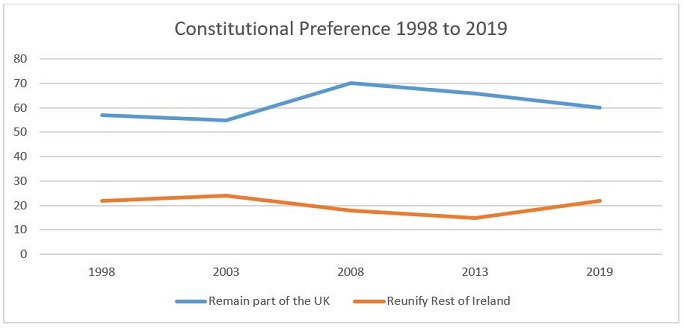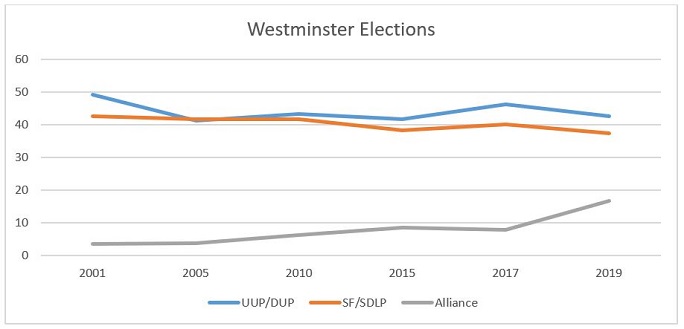Some hint and some are more forceful in their suggestion that SDLP, Sinn Fein and the Irish government are not pushing for a border poll as they believe they should. Also within that world of Irish unity are voices that contend that Northern Ireland has to work or be seen to working while others do not wish for it to work. Some are for embedding reconciliation and some are not. The border poll at ‘all costs brigade’ will not consider the surveys which show that the demand is not growing for unification and instead favour polls which show support on a knife-edge.
So let us go through a few things as I see it.
The Desire for Unification is Growing
We are told by those who are pro-unity that the desire for unification is growing. Let us consider survey data:
- According to the Life and Times Survey since 1998 support for Irish unification has fallen from 24% to 22%.
- It is true that it has grown from 2013 from 15% which is probably due to demography and Brexit.

Let us now consider the claim that the nationalist and republican vote is growing. If we look at Westminter elections since 2001 the share of the votes fo the DUP and UUP has fallen from around 50% to 42.7%. However, the combined vote for the SDLP and SF has also fallen by from 41.8% to 37.5%. What has also happened is that Alliance vote has grown from 3.9% to 16.8% and there has also been a growth in votes for smaller parties as well. The claim that Brexit mobilised the nationalist and republican vote is just not true. Between 2017 and 2019 the SDLP/SF vote fell from 40.1% to 37.5%. So are pro-unity voters going to Alliance? Yes but not in great numbers. In fact Alliance voters are split, with 58.8% for the union and 25.6% for reunification. Moreover, 29.1% of SDLP voters are undecided or pro-union.

What pro-unity people do not recognise (well publicly) is that many who consider themselves as Irish are banal nationalists. They may wish for a united Ireland but fear its costs and implications. These people are never mentioned or considered by the pro-unity camp as having an ambiguity about the constitutional future. In particular, if a united Ireland happened it could lead to a decline in public sector employment (in which many middle class Catholics work). Turkeys for Christmas out there?
The Lucid Poll of January 2021 had support for unification at 42% which is much higher than the Life and Times Survey. Important to note that support for unification was down 3% on the previous poll conducted a year ago,
So why are we getting different results? The methods used are the answer. Household surveys are face to face and while another medium is other online polling.
Surveys or Polls?
Household surveys, such as those conducted by universities, are questionnaires that are given to a sample of households in a population. Their primary advantage is that they provide considerable discretion to the interviewer about the information requested of respondents. Their major drawback is that information provided by the respondent can be inaccurate (response error), and, in many cases, the information requested is not provided at all (nonresponse problems). Despite the challenges it currently faces, survey research is relatively robust. For most survey modes, accurate samples can be achieved because survey researchers well understand the nature of sampling. The challenge is to ensure that sampling frames are reasonably complete. Improvements in large-scale database construction permits researchers to improve sampling frames for all types of surveys. Furthermore, online polling at times captures fewer people who vote because people sign up for online polling as they are interested in issues and politics. What we know from the Good Friday Agreement referenda was that a yes or no vote achieved really high electoral turnout compared to most previous and later elections. As the household survey shows the majority who do not vote are more likely to be pro-union. That does not mean they will vote but it also does not mean that they will not.
The benefits of online polling are many. They can achieve robust sample sizes, they can report accurate and meaningful results, they can bring into play sophisticated segmentation and higher participation rates, contain cost-savings, generate results quickly and provide the capacity to mine data for impactful insights. We have criticised household surveys above so it is only right to do so here also. As PollUnit declare:
In general it is difficult to avoid multiple participation… A participant from another computer can reopen the poll and vote again.
As the Pew Research Centre noted in 2020:
‘… opt-in survey panel respondents were more likely than those recruited via random sampling of addresses to give bogus data’.
Conclusion
Despite different data and arguments over robustness and accuracy it is important to note that those who wish for a united Ireland are calling for a debate with those who disagree. Those, who are pro-union should engage. It is a folly for those who are pro-union not to engage in that debate.
Back to: Institute of Irish Studies